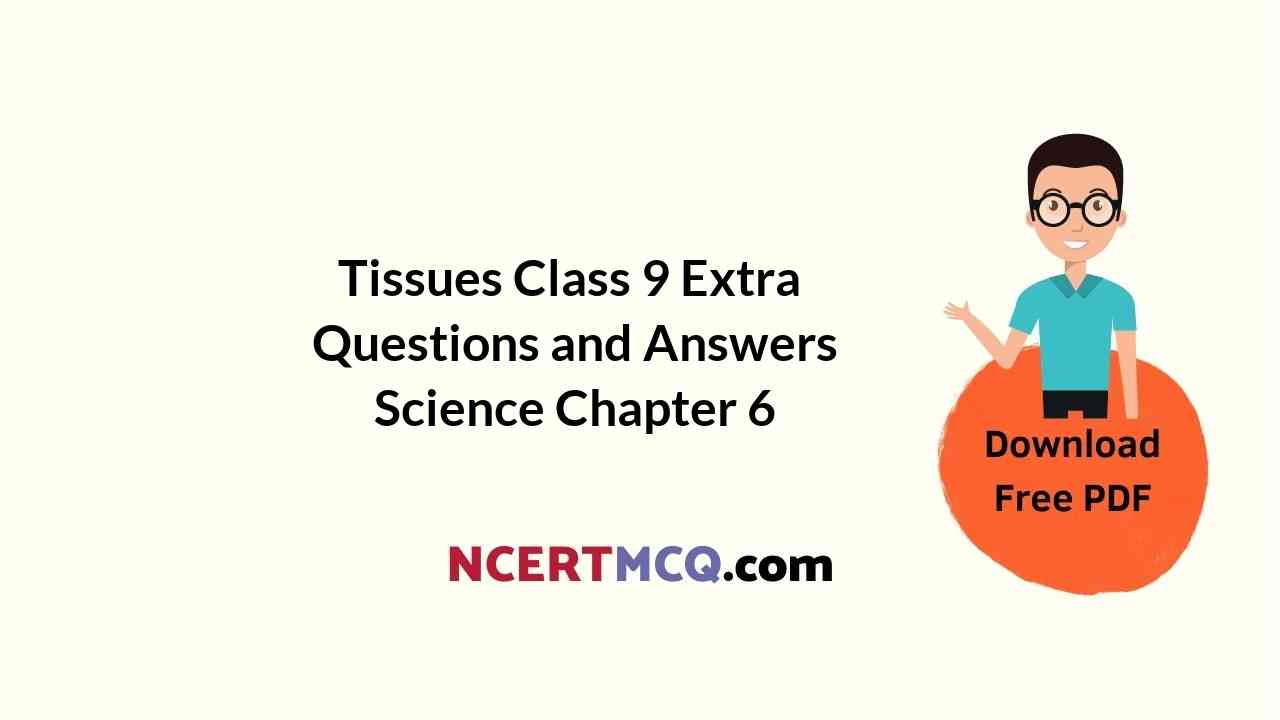In this page, we are providing Tissues Class 9 Extra Questions and Answers Science Chapter 6 pdf download. NCERT Extra Questions for Class 9 Science Chapter 6 Tissues with Answers will help to score more marks in your CBSE Board Exams. https://ncertmcq.com/extra-questions-for-class-9-science/
Class 9 Science Chapter 6 Extra Questions and Answers Tissues
Extra Questions for Class 9 Science Chapter 6 Tissues with Answers Solutions
Tissues Class 9 Extra Questions Very Short Answer Type
Class 9 Science Chapter 6 Tissue Extra Question Answer Question 1.
Name any two types of simple permanent plant tissues.
Answer:
The simple permanent tissues of plants are: Parenchyma, collenchyma and sclerenchyma.
Tissues Class 9 Extra Questions With Answers Question 2.
What are blood platelets?
Answer:
Blood platelets are the cell fragments present in the plasma of blood which help in the clotting of blood.
Tissue Class 9 Extra Questions And Answers Question 3.
Name the connective tissue that is found between skin and muscles.
Answer:
Areolar tissue.
Tissues Extra Questions And Answers Question 4.
Name the tissue present in the brain.
Answer:
Nervous tissue which comprises of its basic unit called neurons.
Class 9 Tissue Extra Questions Question 5.
In which of the simple plant tissue, deposition of lignin is found?
Answer:
Sclerenchyma.
Tissues Class 9 Extra Questions Question 6.
Name the basic packing tissue of plant.
Answer:
Parenchyma.
Tissue Extra Questions Class 9 Question 7.
Name the tissue which is present in the veins of leaves.
Answer:
Sclerenchyma.
Class 9 Science Chapter 6 Extra Questions And Answers Question 8.
Why is cork impervious to gases and water?
Answer:
Due to presence of a chemical substance called suberin.
Class 9 Tissues Extra Questions Question 9.
What is the function of phloem?
Answer:
Phloem helps in the transport of food from leaves to the various parts of the plant.
Extra Questions On Tissues Class 9 Question 10.
Which body cell provides resistance against infections?
Answer:
White blood cells (WBC) provide resistance against infections.
Extra Questions Of Tissue Class 9 Question 11.
Which biochemicals compose the solid matrix of cartilage?
Answer:
Proteins and sugars make up the solid matrix of cartilage.
Tissue Class 9 Extra Questions Question 12.
Name the connective tissue which helps in the repair of tissues.
Answer:
Areolar connective tissue helps in the repair of tissue.
Class 9 Science Ch 6 Extra Questions Question 13.
Which connective tissue is specialised for fat storage and acts as heat insulator?
Answer:
Adipose tissue helps in storage of fats and acts as heat insulator.
Tissue Chapter Class 9 Extra Questions Question 14.
Which muscle has spindle-shaped cells?
Answer:
Smooth muscle cells have spindle shaped cells.
Ch 6 Science Class 9 Extra Questions Question 15.
Which meristem is present at growing tips of stems and roots?
Answer:
Apical meristem is present at the growing tips of the stem and roots.
Tissues Class 9 Extra Questions Short Answer Type 1
Question 1.
List any four salient features of meristematic tissue.
Answer:
The salient features of meristematic tissue are:
- This tissue consists of cells which continuously divide to produce new cells.
- The cells of this tissue lack vacuoles.
- The cells of this tissue have dense cytoplasm.
- The cells of this tissue have thin cellulosic cell walls and prominent nuclei.
Question 2.
Write the four elements of xylem.
Answer:
The four elements of xylem are tracheids, vessels, xylem parenchyma and xylem fibres.
Question 3.
How is ligament different from tendons?
Or
Differentiate between tendon and ligament.
Answer:
Ligament is a connective tissue which joins bone to bone and is elastic in nature.
Tendons join bone to muscles and are less elastic as compared to the ligaments.
Question 4.
Write a short note on the different types of meristematic tissue with their location and functions in the plants.
Answer:
The meristematic tissues are classified as apical, lateral and intercalary meristematic tissue based on the region where they are present.
Apical meristem – It is present at the growing tips of stem and roots and results in increase in the length of the stem and the root. Lateral meristem (cambium): It is present on the lateral sides of stem and roots. It helps to increase the girth of the stem or root.
Intercalary meristem – It is present at the base of the leaves or internodes. It helps in the longitudinal growth of plants.
Question 5.
Show the diagrammatic representation of location of lateral meristem and intercalary meristem in plant body.
Answer:
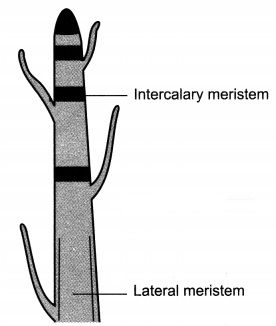
Question 6.
Differentiate between chlorenchyma and aerenchyma.
Or
Write the difference between aerenchyma and chlorenchyma.
Answer:
Chlorenchyma:
- It is a type of parenchyma which contains chlorophyll.
- It helps to perform photosynthesis.
- It is present in green parts of plants like the leaves.
Aerenchyma:
- This type of parenchyma that has large air cavities in it.
- It helps to provide buoyancy to the plants.
- It is present in the aquatic plants, example in their floating leaves.
Question 7.
Write the functions of collenchyma in plants.
Answer:
Collenchyma allows easy bending in various parts of a plant (leaf, stem) without breaking. It also provides mechanical support to plants like in the leaf stalks below the epidermis.
Question 8.
What are the roles of epidermis in plants?
Answer:
The functions of epidermis are:
- Epidermis is usually made up of a single layer of cells and gives protection.
- The epidermis may be thicker in some plants living in dry habitats or often secrete a waxy, water- resistant layer on their outer surface called cutin (chemical substance with waterproof quality) to prevent water loss.
- The epidermis of leaves have small pores called as stomata which help in gaseous exchange and transpiration.
- The epidermal cells of roots bear root hairs that greatly increase the total absorptive surface area of the roots for absorption of water.
Question 9.
Answer the following:
(i) How is the epidermis of the plants living in very dry habitats adapted?
(ii) Write functions of guard cells of stomata in the leaf.
Answer:
(i) The epidermis of plants living in dry habitats may be thicker or often secrete a waxy, water-resistant layer on their outer surface called cutin (chemical substance with waterproof quality) to prevent water loss.
(ii) The guard cells of stomata in the leaf help in gaseous exchange and transpiration.
Question 10.
What is the function of areolar tissues?
Answer:
The functions of areolar tissues are:
- It fills the space inside the organs
- It supports internal organs.
- It helps in repair of tissues.
Question 11.
Determine the location of the following tissues:
- Unstriated muscle fibres
- Cuboidal epithelium
- Adipose tissue
- Striated muscle fibres
Answer:
- Unstriated muscle fibres: Present in iris of the eye, ureters, blood vessels, alimentary canal and bronchi of lungs.
- Cuboidal epithelium: Present in lining of kidney tubules and ducts of salivary glands.
- Adipose tissue: It is found below the skin and between internal orgAnswer:
- Striated muscle fibres: It is present in muscles of our limbs
Tissues Class 9 Extra Questions Short Answer Type 2
Question 1.
Explain how the bark of a tree is formed. How does it act as a protective tissue?
Answer:
In the older stem, a strip of secondary meristem replaces the epidermis. The secondary meristem cuts off cells towards outside to form a several-layer thick tissue; This is called the cork or the bark of the tree.
Cells of cork or bark are dead, compactly arranged without intercellular spaces and have a chemical called suberin in their walls that makes them impervious to gases and water. In this way it acts as a protective tissue.
Question 2.
Draw a diagrammatic labelled sketch of stem tip to show location of meristematic tissue. Mention the functions of different types of meristematic tissue.
Answer:
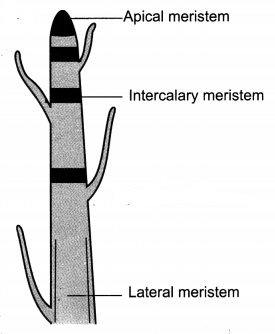
The types of meristematic tissue are:
(i) Apical meristem: It is present at the growing tips of stems and roots and results in increase in the length of the stem and the root.
(ii) Lateral meristem (cambium): It is present on the lateral sides of stems and roots. It helps to increase the girth of the stem or root.
(iii) Intercalary meristem: It is present at the base of the leaves or internodes. It helps in the longitudinal growth of plants.
Question 3.
What are the two main components of blood? Why is blood considered a type of connective tissue?
Answer:
Blood is a special connective tissue consisting of a fluid matrix, plasma, and formed elements. The formed elements are red blood cells (RBCs), white blood cells (WBCs) and blood platelets. Blood is considered as a type of connective tissue as they have the same origin as other types of connective tissue and helps to connect the different parts of the body to facilitate exchange of various components like nutrients and gases.
Question 4.
Give one function of each of the following.
(i) Stomata
(ii) Root nodules
(iii) Cardiac muscle fibres
Answer:
(i) Stomata: Help in exchange of gases in the plants.
(ii) Root nodules: In leguminous plants, the root nodules harbour nitrogen fixing bacteria which convert atmospheric nitrogen into nitrates.
(iii) Cardiac muscle fibres: They help in rhythmic contraction and relaxation of the heart.
Question 5.
Differentiate between bone and cartilage.
Or
Differentiate between bone and cartilage with respect to structure, function and location.
Answer:
Bone:
- Bones have a hard and non-pliable ground substance.
- Its matrix is rich in calcium salts and collagen fibres.
- It is the main tissue that provides structural frame to the body.
- The bone cells (Osteocytes) are present in the spaces called lacunae.
- Bones are present in the limbs and form main skeletal framework of the body.
Cartilage:
- Cartilage is pliable, flexible and resist compression.
- Its matrix is rich in protein called chondrin and sugars.
- It is present in bones of the vertebral column, limbs and hands in adults.
- Cells of this tissue (chondrocytes) are enclosed in small cavities within the matrix secreted by them.
- Cartilage is present in the tip of nose, outer ear joints, between adjacent bones of the vertebral column.
Question 6.
Explain the basic criteria for classification of permanent tissue in plants.
Answer:
The permanent tissues are classified on the basis of the following criteria:
- Simple (made of one type of cell) or complex (made of more than one type of cells)
- Cell wall: Thin or thick
- Type of cell: living or dead
- Type of function the tissue performs: epidermis is protective, parenchyma is packing or supportive tissue and sclerenchyma makes up conducting tissue.
Question 7.
Identify the given two slides A and B as a parenchyma or sclerenchyma. Sclerenchyma can be identified by which characteristic?
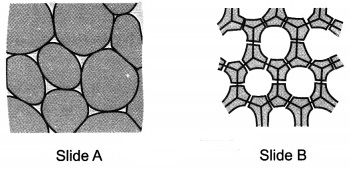
Answer:
Slide A is parenchyma and Slide B is sclerenchyma.
Sclerenchyma can be identified by the type of cells which are long and narrow as the walls are thickened due to presence of lignin.
Question 8.
(i) Identify the given figures.
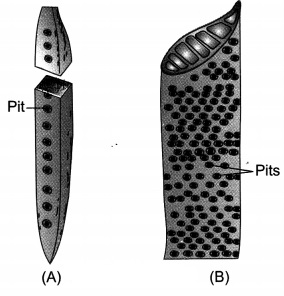
(ii) Give any two major differences between the structures identified.
(iii) Describe the role performed by these two in the plant body.
Answer:
(i) Structure (A) is a tracheid and structure (B) is a vessel.
(ii) Tracheid:
- Tracheids are elongated or tube-like cells with thick and lignified walls and tapering ends.
- They are in the form of single cells.
Vessel:
- Vessel is a long cylindrical tube-like structure made up of many cells called vessel members.
- They are composed of a number of cells fused together.
(iii) Tracheids and vessels help in vertical transport of water and minerals in the plants. They also help to provide mechanical strength to the plants.
Question 9.
Draw a well labelled diagram of cardiac muscle found in the human body. Write two differences between striated and smooth muscles.
Answer:

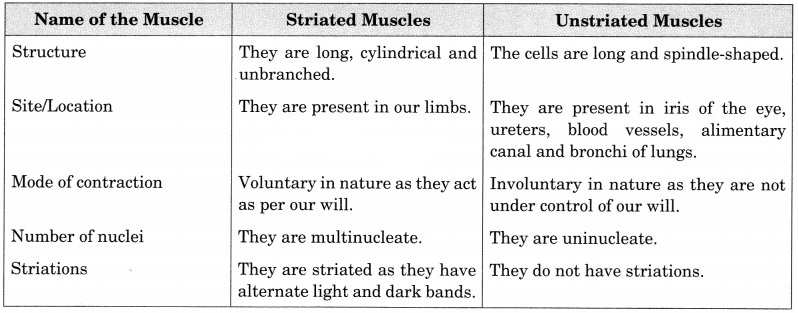
Question 10.
Draw a labelled diagram of unstriated muscle tissue and mention its occurrence, features and functions.
Answer:
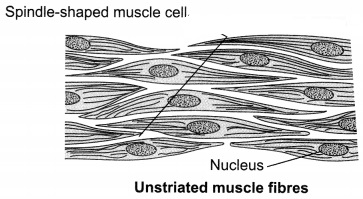
(i) The cells are long and spindle-shaped.
(ii) They do not have striations.
(iii) Involuntary in nature as they are not under control of our will.
(iv) The cells of smooth muscles are uninucleate.
(v) Smooth muscle fibres are present in iris of the eye, ureters, blood vessels, alimentary canal and bronchi of lungs.
Question 11.
Name the kinds of muscles found in your limbs and lungs. How do they differ from each other structurally and functionally?
Answer:
Striated muscle fibres are found in limbs whereas smooth muscle fibres are present in lungs. The differences in their structure are:
(i) Striated muscle fibres have alternate light and dark bands which are not present in the smooth muscle fibres.
(ii) Striated muscle fibres are cylindrical and multinucleate whereas the smooth muscle fibres are spindle-shaped and uninucleate.
(iii) Striated muscles are voluntary in nature (under control of our will) whereas the smooth muscle fibres are involuntary in nature (not under control of our will).
Question 12.
What are neurons? Where are they found in the body? What function do they perform in the body of an organism?
Answer:
The cells of nervous tissue are called nerve cells or neurons. Neurons are the structural and functional unit of the nervous system. They are found in the brain, spinal cord and nerves.
Their functions are:
- They are highly specialised for transmitting the stimulus from one place to another within the body on being stimulated.
- They help to coordinate the various functions of the body.
Question 13.
Animals of colder regions and fishes of cold water have thicker layer of subcutaneous fat. Describe why?
Answer:
The thick layer of subcutaneous fat acts as insulator and prevents the heat of the body to escape out. The layer of fat acts as a subcutaneous insulation of body for thermoregulation.
Question 14.
Match the column (A) with the column (B).
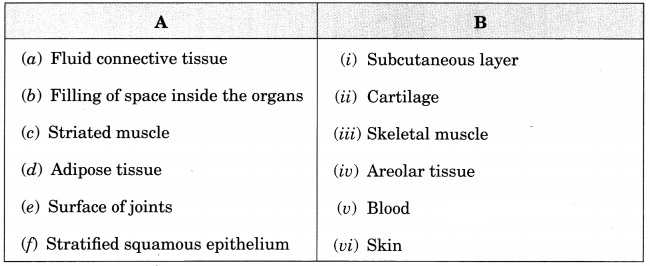
Answer:
(a) (v)
(b) (iv)
(c) (iii)
(d) (i)
(e) (ii)
(f) (vi)
Question 15.
Match the column (A) with the column (B).
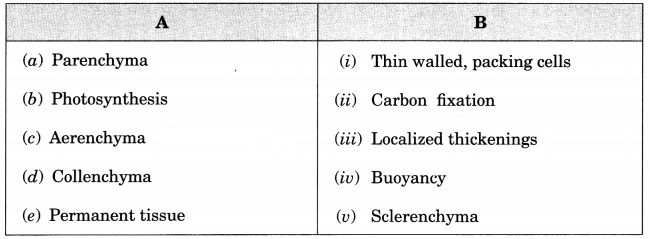
Answer:
(a) (i)
(b) (c)
(d) (iii)
(e) (iv)
Question 16.
If a potted plant is covered with a glass jar, water vapours appear on the wall of glass jar. Explain why.
Answer:
The water is lost by the plant in the form of water vapour due to the process of transpiration. These water vapours appear on the wall of the glass jar.
Question 17.
Name the different components of xylem and draw a living component.
Answer:
Xylem consists of four elements which are:
(a) tracheids
(b) vessels
(c) xylem parenchyma
(d) xylem fibres
The only living component of xylem is xylem parenchyma whose basic structure is shown below:
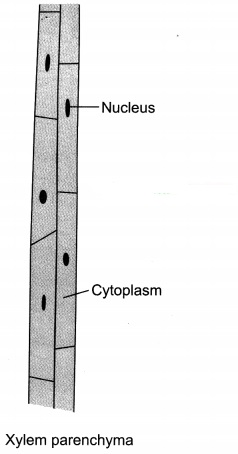
Question 18.
Draw and identify different elements of phloem.
Answer:
Phloem has four elements called sieve tubes, companion cells, phloem fibres and the phloem parenchyma.
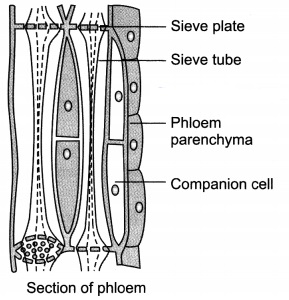
Question 19.
Write true (T) or false (F).
(a) Epithelial tissue is protective tissue in animal body.
(b) The lining of blood vessels, lung alveoli and kidney tubules are all made up of epithelial tissue.
(c) Epithelial cells have a lot of intercellular spaces.
(d) Epithelial layer is permeable layer.
(e) Epithelial layer does not allow regulation of materials between body and external environment.
Answer:
(a) True
(b) True
(c) False
(d) True
(e) False
Question 20.
Differentiate between voluntary and involuntary muscles. Give one example of each type.
Answer:
Voluntary muscles are present in our limbs as skeletal muscles and can be moved by our conscious will whenever we want. Involuntary muscles cannot function on their own. They cannot be controlled by our will or desire. The cardiac muscle and the smooth muscles are involuntary in nature.
Question 21.
Differentiate the following activities on the basis of voluntary (V) or involuntary (IV) muscles.
(a) Jumping of frog
(b) Pumping of the heart
(c) Writing with hand
(d) Movement of chocolate in your intestine
Answer:
(a) (V)
(b) (IV)
(c) (V)
(d) (IV)
Question 22.
Fill in the blanks.
(a) Lining of blood vessels is made up of _______
(b) Lining of small intestine is made up of _______
(c) Lining of kidney tubules is made up of _______
(d) Epithelial cells with cilia are found in _______ of our body.
Answer:
(a) Squamous epithelium
(b) Columnar epithelium
(c) Cuboidal epithelium
(d) Respiratory tract
Question 23.
Water hyacinth floats on water surface. Explain.
Answer:
The parenchyma present in the swollen petiole of water hyacinth is called aerenchyma which has large cavities to provide buoyancy and help them float on the water surface.
Question 24.
Which structure protects the plant body against the invasion of parasites?
Answer:
The epidermis of plants has thick cuticle and waxy substances to prevent the invasion of parasites.
Question 25.
Fill in the blanks.
(а) Cork cells possesses _______on their walls that makes it impervious to gases and water.
(b) _______ have tubular cells with perforated walls and are living in nature.
(c) Bone possesses a hard matrix composed of and _______ and _______
Answer:
(a) suberin
(b) sieve tubes
(c) calcium and phosphorus
Question 26.
Why is epidermis important for the plants?
Answer:
The outermost layer of cells covering an organism is called epidermis. It is usually made up of a single layer of cells and gives protection.
The epidermis may be thicker in some plants living in dry habitats or often secrete a waxy, water- resistant layer on their outer surface called cutin (chemical substance with waterproof quality) to prevent water loss.
The stomata present on the epidermis of leaves helps in gaseous exchange and the loss of water vapour by transpiration.
The epidermal cells of roots bear root hairs that greatly increase the total absorptive surface area of the roots for absorption of water.
Question 27.
Fill in the blanks.
(a) _______ are forms of complex tissue.
(b) _______ have guard cells.
(c) cells of cork contain a chemical called _______
(d) Husk of coconut is made of _______ tissue.
(e) _______ gives flexibility in plants.
(f) _______ and _______ are both conducting tissues.
(g) Xylem transports and _______ and _______ from soil.
(h) Phloem transport from _______ and _______ to other parts of the plant.
Answer:
(a) Xylem and phloem
(b) Stomata
(c) suberin
(d) sclerenchyma
(e) Collenchyma
(g) water; minerals
(h) Food; leaf
Tissues Class 9 Extra Questions Long Answer Type
Question 1.
Differentiate between
(i) Xylem and phloem
(ii) Vessel and sieve tube
(iii) Tracheid and vessel
Answer:
(i) Xylem and phloem –
Xylem:
- Xylem consists of tracheids, vessels, xylem parenchyma and xylem fibres.
- All the cells of xylem except the xylem parenchyma are dead.
- Xylem helps to transport water and minerals.
- The transport is unidirectional through xylem.
Phloem:
- Phloem has four elements called sieve tubes, companion cells, phloem fibres and the phloem parenchyma.
- All cells of phloem are living except the phloem fibres.
- Phloem transports food from leaves to other parts of the plant.
- The transport is bidirectional through the phloem.
(ii) Vessel and sieve tube –
Vessel:
- They are tubular structures having a hollow lumen and composed of dead cells.
- Vessel helps to conduct water and minerals in plants.
- The walls of vessels are lignified.
- They also provide mechanical strength to the plants.
- Their end walls are completely dissolved.
Sieve Tube:
- They are tubular structures having vacuolated cytoplasm and composed of living cells.
- They help to transport food from leaves to other parts of the plant.
- Their walls are not lignified.
- They do not provide mechanical strength to the plants.
- Their end walls have perforations in form of sieve plate.
(iii) Tracheid and vessel _
Tracheid:
- Tracheids are elongated or tube-like cells with thick and lignified walls and tapering ends.
- They are in the form of single cells.
- The inner layers of the cell walls are more thickened.
- They have narrow lumen.
- They have pointed ends.
Vessel:
- Vessel is a long cylindrical tube-like structure made up of many cells called vessel members.
- They are composed of a number of cells fused together.
- Their walls are less thickened.
- They have wide lumen.
- They have blunt ends.
Question 2.
Differentiate between striated, unstriated and cardiac muscle fibres.
Answer:
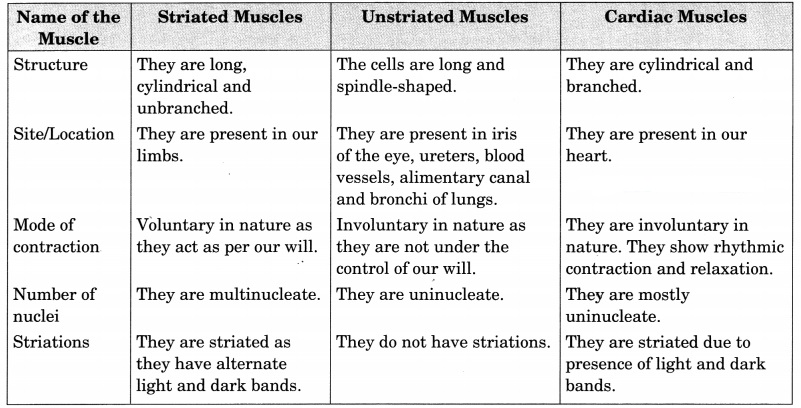
Question 3.
(i) What is nervous tissue?
(ii) Draw a well labelled diagram of neuron. (Label any 4 parts)
Answer:
Nervous tissue is a tissue made of neurons. It is divided into two parts: the central nervous system (CNS) consisting of the brain and spinal cord; and the peripheral nervous system (PNS) which regulates and controls the various functions and activities of the body.
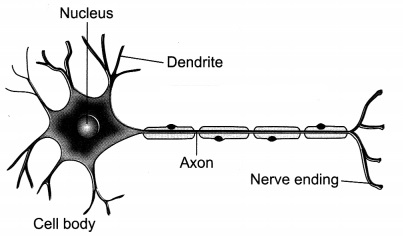
Question 4.
Write the differences between animal tissue and plant tissue.
Answer:
Plant Tissue:
- The tissue is well differentiated into meristematic tissue and permanent tissue.
- The tissue can grow throughout life due to activity of meristematic tissue.
- They are autotrophic in nature.
- The tissue has more amount of dead tissue which provides mechanical strength to the plants.
- The tissue organisation is comparatively simple.
Animal Tissue:
- The tissue is not much differentiated like the plant tissue.
- The tissue does not show growth throughout life.
- They are heterotrophic in nature.
- The tissue has more amount of living tissue than dead tissue.
- The tissue is complex as it is organised into organs and organ systems.
Question 5.
Write a note on the protective tissue in plants. (Give appropriate diagram also)
Answer:
The protective tissues in plants are epidermis and the cork.
(i) Epidermis: The outermost layer of cells covering an organism is called epidermis. It is usually made up of a single layer of cells and gives protection.
The epidermis may be thicker in some plants living in dry habitats or often secrete a waxy, water- resistant layer on their outer surface called cutin to prevent water loss.
The epidermis of leaves have small pores called stomata which are enclosed by two kidney-shaped cells called guard cells. Stomata help in gaseous exchange and transpiration.
The epidermal cells of roots bear root hairs that greatly increase the total absorptive surface area of the roots for absorption of water.
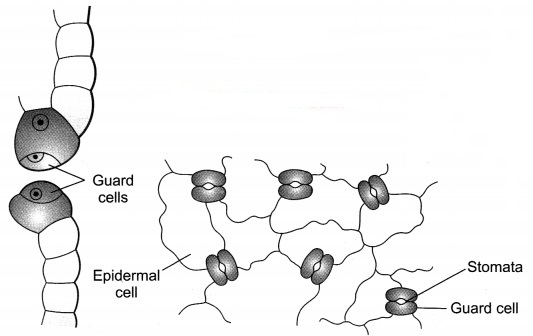
(ii) Cork: A strip of secondary meristem replaces the epidermis of the older stem and cuts off cells towards compactly arranged without intercellular spaces and have a chemical called suberin in their walls that makes them impervious to gases and water.
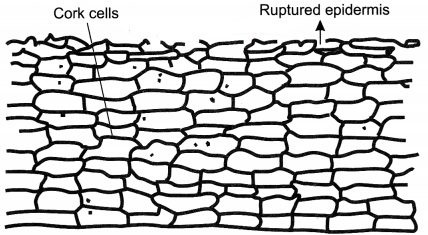
Question 6.
Explain the significance of the following:
(i) Hair-like structures on epidermal cells.
(ii) Epidermis has thick waxy coating of cutin in desert plants.
(iii) Small pores in epidermis of leaf.
(iv) Numerous layers of epidermis in cactus.
(v) Presence of a chemical suberin in cork cells.
Answer:
(i) To increase the total absorptive surface area for absorption of water.
(ii) To prevent water loss by transpiration and protection from pathogens.
(iii) To help in gaseous exchange and transpiration.
(iv) To prevent water loss by transpiration.
(v) To make tissue impervious to gases and water.
Question 7.
Differentiate between sclerenchyma and parenchyma tissues. Draw well labelled diagram.
Answer:
Parenchyma:
- Cells are thin walled and thickened with cellulose.
- It is made up of living cells.
- Cells are usually loosely pac ked with large intercellular spaces.
- Helps to store nutrients and water in stem and roots.
- It is called chlorenchyma if it contains chlorophyll and performs photos ynthesis. The parenchyma of
- aquatic plants have large cavities to provide buoyancy to the plants to help them float, it is then called aerenchyma.
Sclerenchyma:
- Cells are thick and thickened with lignin.
- This tissue is made up of dead cells.
- There are no intercellular spaces between the cells.
- Provides strength to the various parts of the plant.
- The cells are long and narrow, make the plant hard and stiff. This tissue provides strength to the plants and is present in stems, around vascular bundles, in the veins of leaves and in the hard covering of seeds and nuts.
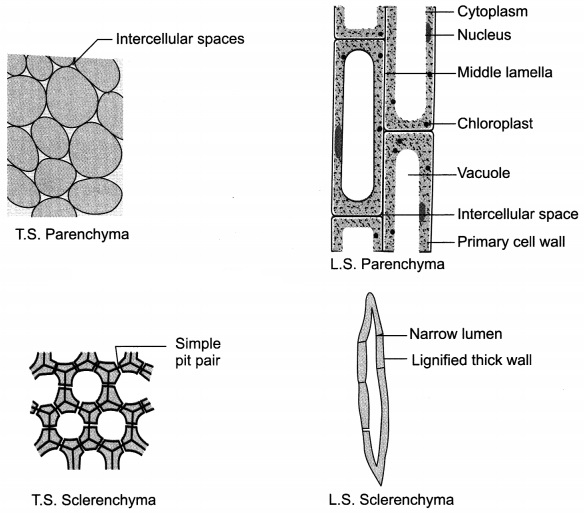
Question 8.
Describe the structure and function of different types of epithelial tissues. Draw diagram of each type of epithelial tissue.
Answer:
Epithelial tissues are the covering or protective tissues and cover most organs and cavities in the animal body. These cells are tightly packed, form a continuous sheet and are almost without any intercellular spaces between them. E.g., skin, the lining of the mouth, the lining of blood vessels, lung alveoli and kidney tubules are all made of epithelial tissue.
All epithelium is usually separated from the underlying tissue by an extracellular fibrous basement membrane. The types of epithelium on the basis of their structure and functions are:
(a) Squamous epithelium: Consists of flattened cells. Present in oesophagus and lining of the mouth. Skin epithelial cells are arranged in many layers to prevent wear and tear and are called stratified squamous epithelium.
(b) Columnar epithelium: Has tall or ‘pillar-like’ cells. It forms the inner lining of the intestine.
(c) Cuboidal epithelium: Has cube-shaped cells. It forms the lining of kidney tubules and ducts of salivary glands, where it provides mechanical support.
(d) Ciliated epithelium: Have cilia on the outer surfaces of epithelial cells. The cilia can move and their movement pushes the mucus in the respiratory tract forward to clear it.
(e) Glandular epithelium: Has gland cells which secrete substances at the epithelial surface.

Question 9.
Give reasons for
(a) Meristematic cells have a prominent nucleus and dense cytoplasm but they lack vacuole.
(b) Intercellular spaces are absent in sclerenchymatous tissues.
(c) We get a crunchy and granular feeling, when we chew pear fruit.
(d) Branches of a tree move and bend freely in high wind velocity.
(e) It is difficult to pull out the husk of a coconut tree.
Answer:
(a) Because the meristematic cells are actively dividing cells and there is no need of storage.
(b) Because they have a thick deposition of lignin in them.
(c) Due to the presence of stone cells (sclerenchyma) in the pear fruit.
(d) Due to the presence of collenchyma which provides flexibility to the various parts of the plant.
(e) Due to the sclerenchyma present in the husk of the coconut.
Question 10.
List the characteristics of cork. How are they formed? Mention their role.
Answer:
The characteristics of cork are:
- Cells of cork are dead at maturity.
- These cells are compactly arranged.
- Cells do not possess intercellular spaces.
- Cells possess a chemical substance suberin in their walls.
- They are several layers thick.
A strip of secondary meristem replaces the epidermis of the older stem and cuts off the outside cells to form a several-layer thick cork or the bark of the tree. Cells of cork are dead, compactly arranged without intercellular spaces and have a chemical called suberin in their walls that makes them protective in function and impervious to gases and water.
Question 11.
(a) Differentiate between meristematic and permanent tissues in plants.
(b) Define the process of differentiation.
(c) Name any two simple and two complex permanent tissues in plants.
Answer:
(a) Meristematic tissue:
- This tissue consists of cells which continuously divide to produce new cells.
- They are located at specific regions of the plant, i.e., apical, lateral and intercalary.
- The cells of this tissue are very active, lack vacuoles, have dense cytoplasm, thin cell walls and prominent nuclei.
Permanent tissue:
- Consists of cells which have taken up a specific role and lost the ability to divide.
- They are distributed throughout the plant body.
- They are vacuolated, vary in shape and size. Their cell wall may be thick.
(b) The process of taking up a permanent shape, size, and a function by the cells is called differentiation.
(c) Simple: Parenchyma/collenchyma/sclerenchyma Complex: Phloem/xylem
Tissues Class 9 Extra Questions HOTS
Question 1.
The walls of the sclerenchymatous cells are thickened and have narrow lumen. Which substance thickens it and what is its role?
Answer:
The walls of the sclerenchymatous cells are thickened due to presence of lignin. It helps in providing mechanical strength to the various parts of the plant.
Question 2.
Which type of muscle fibres will contract to remove your hands instantly when you touch a hot object?
Answer:
Striated muscle fibres will contract to remove our hands instantly when we touch a hot object.
Question 3.
Which tissue helps the leaves of lotus plant to float on water? Why?
Answer:
Aerenchyma helps the leaves of lotus plant to float on water. Aerenchyma has large cavities to provide buoyancy to the parts of aquatic plants.
Question 4.
A tissue present in plants helps in storing food and sideways conduction of water. Identify the type of tissue.
Answer:
The tissue is xylem parenchyma.
Question 5.
Which tissue enables the heart to pump blood to various parts of the body? Why?
Answer:
The cardiac muscles help the heart to pump blood to various parts of the body as they show rhythmic contraction and relaxation throughout their life.
Question 6.
What will be the consequence of
(i) removal of blood platelets from blood?
(ii) removal of cutin from the layer of epidermis?
Answer:
(i) Removal of blood platelets from blood will inhibit clotting of blood if an injury occurs and the person may bleed to death.
(ii) Removal of cutin would increase the amount of water loss from the leaves of the plants.
Question 7.
Some actions of our body are under our control but many of them are not under our control. Why is it so?
Answer:
The actions of our body are controlled by our muscles. The voluntary actions are under the control of our will and are caused by the activity of striated muscles, eg., movement of our limbs. The involuntary . actions are not under the control of our will and are performed by the smooth muscles, e.g., the activity of bronchi of lungs. Even the activity of cardiac muscles which helps in the rhythmic contraction and relaxation of heart are involuntary in nature.
Question 8.
Which kind of meristem can help grasses to regenerate parts removed by the grazing herbivores?
Answer:
Intercalary meristem can help grasses to regenerate parts removed by the grazing herbivores.
Question 9.
Name the tissue which replaces the epidermal tissue in older stem and is rich in suberin. What is the function of suberin?
Answer:
Cork is the tissue which replaces the epidermal tissue in older stem and is rich in suberin. Suberin present in the walls of cork cells makes them impervious to gases and water.
Question 10.
The process of transpiration does not occur properly when the leaves are covered by a layer of oily substance. Why? Which other functions will get affected due to this covering?
Answer:
The layer of oily substance will close the stomata present in leaves and this would decrease the rate of transpiration. The rate of exchange of gases decreases and consequently the rate of photosynthesis would also decrease.
Tissues Class 9 Extra Questions Value Based (VBQs)
Question 1.
Raman got injured while playing football. His injured leg started bleeding and his friends immediately rushed to take him to the doctor to give him first aid. The blood flowing from the wound stopped after some time and the doctor applied antiseptic on the wound.
(i) Why did the blood stop flowing after some time from the wound?
(ii) What kind of tissue is blood? Why?
(iii) What values are shown by Raman’s friends?
Answer:
(i) The blood stopped flowing after some time from the wound as the blood platelets present in blood helped in clotting of blood.
(ii) Blood is a connective tissue. Blood is considered as a type of connective tissue as they have the same origin as other types of
connective tissue and helps to connect the different parts of the body.
(iii) The values shown by Raman’s friends are presence of mind, helpful and a caring nature.
Question 2.
During a sports event, Shivani suffered a sprain due to which she was not able to run. Her teacher gave her support and told her that it was due to a ligament tear. She also called the doctor to give treatment to Shivani.
(i) What is a ligament? What kind of tissue is it?
(ii) Which type of fibrous tissue has great strength, limited flexibility and is similar to ligament?
(iii) What values are shown by Shivani’s teacher?
Answer:
(i) Ligament is the connective tissue which connects two bones. It is a kind of connective tissue.
(ii) Tendon is a fibrous tissue that has great strength, limited flexibility and is similar to ligament.
(iii) The values shown by her teacher are knowledge, scientific approach and a caring nature.
Question 3.
Rishi brought an aquatic plant which was floating on the surface to the science laboratory of water. He cut a section of the leaf of the plant and saw a tissue with lot of air cavities in it. He went to his teacher and discussed about the role of the air cavities in the leaves of the aquatic plant.
(i) Which type of tissue present in plants has air cavities?
(ii) What is the role of large air cavities in the leaves of such plants?
(iii) What values are shown by Rishi?
Answer:
(i) Aerenchyma is the tissue present in the plants and has large air cavities.
(ii) The large air cavities in the leaves of such plants help in providing buoyancy to the leaves to help them float on water.
(iii) Rishi shows a scientific attitude, inquisitive nature and empirical approach.
